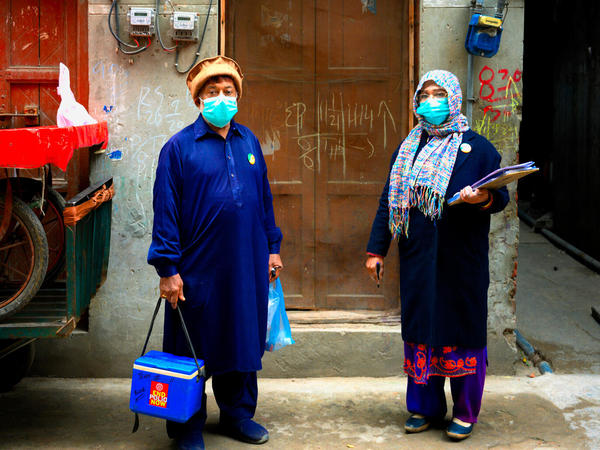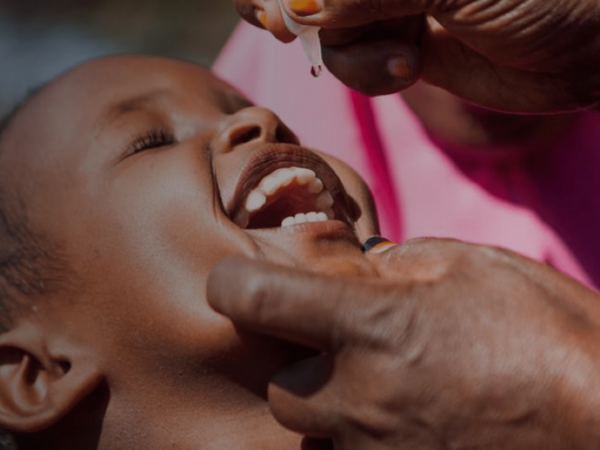here are three principles that all of our polio materials and communications must adhere to:
-
Understand and leverage social perceptions, norms, and beliefs related polio and polio vaccination.
-
Humanize our health workers by emphasizing their social and emotional depth.
-
Continuously refine communications to maintain authenticity and credibility for the target audience(s).
Principle One
Understand and leverage social perceptions, norms, and beliefs related to polio and polio vaccination.
A caregiver's decision to vaccinate takes into account more than just information about polio. Caregivers look to the perceptions, norms, and beliefs of their neighbors and communities when they make the critical decision. Communications can directly address these social factors.
By communicating about beneficial behaviors as normal, we engage these perceptions directly, and, over time, begin to change them. These messages work because they go beyond helpful facts about polio and describe what action to take in response to those facts. For uncertain caregivers, these messages are helpful and let them know they are making the same choice as their peers.
These techniques apply to both mass communications as well as IPC
|
Using Social Norms to Change Behavior Norms are the rules of behavior that are considered acceptable in a group or society. There are two types of norms: descriptive or injunctive. Descriptive Norms: A descriptive norm is a statement that describes a behavior.
Injunctive Norms: An injunctive norm is a statement that describes the social "attitude" towards a descriptive norm.
|
Principle Two
Humanize our health workers by emphasizing their social and emotional depth.
The knock at the door. A visit to a health clinic. A harried encounter at a transit point. Direct, interpersonal contact with a health worker is the primary way our polio vaccination efforts are experienced by caregivers and communities. By humanizing our health workers (i.e. showing them as relatable, familiar, and comforting) in our communications, we make them easier to understand and trust as individuals, and that makes it easier for caregivers to say yes to the polio vaccine. To humanize them in communications, emphasize their social depth by portraying them as members of families, communities, and society, and emphasize their emotional depth by sharing their personal stories.
As communications professionals, we seek to build trust between the vaccinator and the caregiver. There are four important values to achieve this:
1. Genuine concern for children: The caregivers and community need to feel health workers and the program demonstrate genuine empathy for the children they are serving.
2. Morality: Those who work for the program should be considered moral, non-discriminatory, unharmful, and respectful of appropriate gender/cultural considerations for service delivery. The vaccine should be perceived as safe, effective and halal, where appropriate.
3. Honesty: The program and health workers are honest, transparent, and present no ulterior motives. The vaccine is perceived as safe.
4. Competence: Health workers and related program workers are knowledgeable about the vaccine and competent. The vaccine is an effective tool to prevent polio.
Principle Three
Continuously refine communications to maintain authenticity and credibility for the target audience(s).
Communications should feel real, believable, and emotional to the target audiences. To achieve this, they must employ authentic cues and details that show as much as they tell. This is especially crucial if there are significant ethnic, cultural, or religious divisions within the country or region you are working within.
A good way to test for authenticity is to analyze the people and scenes depicted in your communications, and ask members of the target audience for their feedback either through focus groups or in-depth interviews. Members of the target audience should get a distinct impression of who the people are, and what is happening in the scene, purely based on the characteristics and setting portrayed in the communications.
Use the questions here to understand how an audience member views your communication materials and to help tailor materials to appear real and authentic.
Audiences are dynamic, with constantly changing perceptions, attitudes, and behaviors within a complex social system. To account for this, effective communications must also be dynamic and continually adapt to variances in audience norm. Click here to learn more about the Social Ecological Model.
Learn more
Explore the other two learning modules in this 3-step tutorial to design evidence-driven communication strategies to help vaccinate every child.
Define your target audience and barriers to change, then develop messages and choose channels to reach your audience.
You cannot do everything and your ability to prioritize your interventions and target behaviours is paramount. One simple way to do this is to evaluate importance of the behavior and its changeability.



